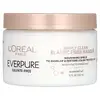What's inside
What's inside
 Benefits
Benefits

 Concerns
Concerns

 Ingredients Side-by-side
Ingredients Side-by-side

Water
Skin ConditioningCetearyl Alcohol
EmollientBehentrimonium Chloride
PreservativeAmodimethicone
Candelilla Cera
EmollientCetyl Esters
EmollientGlycerin
HumectantIsopropyl Alcohol
SolventParfum
MaskingPhenoxyethanol
PreservativeTrideceth-6
EmulsifyingHydroxypropyl Guar
Emulsion StabilisingArginine
MaskingGlutamic Acid
HumectantLinalool
PerfumingHexyl Cinnamal
PerfumingCetrimonium Chloride
AntimicrobialSerine
MaskingChlorhexidine Dihydrochloride
AntimicrobialBenzyl Salicylate
PerfumingHydroxypropyltrimonium Hydrolyzed Wheat Protein
Skin ConditioningBenzyl Alcohol
PerfumingLimonene
PerfumingAmyl Cinnamal
PerfumingCitronellol
Perfuming2-Oleamido-1,3-Octadecanediol
Skin ConditioningAlpha-Isomethyl Ionone
PerfumingCI 19140
Cosmetic ColorantCI 15985
Cosmetic ColorantWater, Cetearyl Alcohol, Behentrimonium Chloride, Amodimethicone, Candelilla Cera, Cetyl Esters, Glycerin, Isopropyl Alcohol, Parfum, Phenoxyethanol, Trideceth-6, Hydroxypropyl Guar, Arginine, Glutamic Acid, Linalool, Hexyl Cinnamal, Cetrimonium Chloride, Serine, Chlorhexidine Dihydrochloride, Benzyl Salicylate, Hydroxypropyltrimonium Hydrolyzed Wheat Protein, Benzyl Alcohol, Limonene, Amyl Cinnamal, Citronellol, 2-Oleamido-1,3-Octadecanediol, Alpha-Isomethyl Ionone, CI 19140, CI 15985
Water
Skin ConditioningCetearyl Alcohol
EmollientBehentrimonium Chloride
PreservativeGlycerin
HumectantButylene Glycol
HumectantAmodimethicone
Cetyl Esters
EmollientIsopropyl Alcohol
SolventPhenoxyethanol
PreservativePEG-90m
Emulsion StabilisingTrideceth-6
EmulsifyingEthylhexyl Salicylate
UV AbsorberChlorhexidine Digluconate
AntimicrobialCetrimonium Chloride
AntimicrobialSalvia Sclarea Oil
MaskingRosmarinus Officinalis Leaf Oil
MaskingIngredients Explained
These ingredients are found in both products.
Ingredients higher up in an ingredient list are typically present in a larger amount.
This water-soluble silicone is used for its hydrating and softening properties. It is used to add a silky feel to skincare products and has great benefits for haircare.
In haircare, this ingredient:
- Adds shine
- Protects color
- Offers thermal protection
- Boosts hair strength
- Does not build up as easily
This ingredient is a preservative and often used for it's anti-static properties. You'll most likely see this ingredient in hair conditioners.
It does not cause irritation or sensitization in leave-on products at 1-5%.
Cetearyl alcohol is a mixture of two fatty alcohols: cetyl alcohol and stearyl alcohol. It is mainly used as an emulsifier. Emulsifiers help prevent the separation of oils and products. Due to its composition, it can also be used to thicken a product or help create foam.
Cetearyl alcohol is an emollient. Emollients help soothe and hydrate the skin by trapping moisture.
Studies show Cetearyl alcohol is non-toxic and non-irritating. The FDA allows products labeled "alcohol-free" to have fatty alcohols.
This ingredient is usually derived from plant oils such as palm, vegetable, or coconut oils. There is debate on whether this ingredient will cause acne.
Due to the fatty acid base, this ingredient may not be Malassezia folliculitis safe.
Learn more about Cetearyl AlcoholThis ingredient is a preservative, antimicrobial, and emulsifier. It is often used in cosmetics for its ability to cleanse, condition, and reduce static.
Cetrimonium chloride is a quaternary ammonium salt, meaning it has a water-soluble structure.
Cetyl Esters is a synthetic wax made up of mostly fatty acids and fatty alcohols. It is strcturally similar to wax taken from whales.
As an emollient, it creates a thin barrier on the skin. This barrier prevents moisture from escaping.
This ingredient may not be fungal-acne safe.
Learn more about Cetyl EstersGlycerin is already naturally found in your skin. It helps moisturize and protect your skin.
A study from 2016 found glycerin to be more effective as a humectant than AHAs and hyaluronic acid.
As a humectant, it helps the skin stay hydrated by pulling moisture to your skin. The low molecular weight of glycerin allows it to pull moisture into the deeper layers of your skin.
Hydrated skin improves your skin barrier; Your skin barrier helps protect against irritants and bacteria.
Glycerin has also been found to have antimicrobial and antiviral properties. Due to these properties, glycerin is often used in wound and burn treatments.
In cosmetics, glycerin is usually derived from plants such as soybean or palm. However, it can also be sourced from animals, such as tallow or animal fat.
This ingredient is organic, colorless, odorless, and non-toxic.
Glycerin is the name for this ingredient in American English. British English uses Glycerol/Glycerine.
Learn more about GlycerinIsopropyl Alcohol is more commonly known as rubbing alcohol. It is most commonly used as a solvent, meaning it helps other ingredients dissolve.
This ingredient is an astringent alcohol. Astringent alcohols may also irritate skin as they high amounts may strip away your skin's natural oils.
Other types of astringent alcohols include:
According to the National Rosacea Society based in the US, you should be mindful of products with these alcohols in the top half of ingredients.
Any type of sanitizing product will have high amounts of alcohol to help kill bacteria and viruses.
Learn more about Isopropyl AlcoholPhenoxyethanol is a preservative that has germicide, antimicrobial, and aromatic properties. Studies show that phenoxyethanol can prevent microbial growth. By itself, it has a scent that is similar to that of a rose.
It's often used in formulations along with Caprylyl Glycol to preserve the shelf life of products.
We don't have a description for Trideceth-6 yet.
Water. It's the most common cosmetic ingredient of all. You'll usually see it at the top of ingredient lists, meaning that it makes up the largest part of the product.
So why is it so popular? Water most often acts as a solvent - this means that it helps dissolve other ingredients into the formulation.
You'll also recognize water as that liquid we all need to stay alive. If you see this, drink a glass of water. Stay hydrated!
Learn more about Water